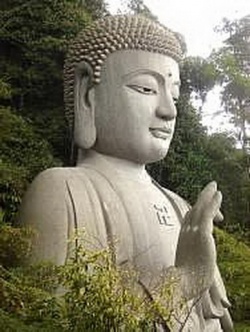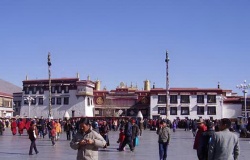Caturmaharajikakayika
Cāturmahārājikakāyika or Cātummahārājika — The world "of the Four Great Kings[[]]" is found on the lower slopes of Mount Sumeru, though some of its inhabitants live in the air around the mountain. Its rulers are the four Great Kings of the name, Virūḍhaka, Dhṛtarāṣṭra, Virūpākṣa, and their leader Vaiśravaṇa. The devas who guide the Sun and Moon are also considered part of this world, as are the retinues of the four kings, composed of Kumbhāṇḍas (dwarfs), Gandharvas (fairies), Nāgas (dragons) and Yakṣas (goblins). The beings of this world are 750 feet (230 m) tall and live for 9,000,000 years (Sarvāstivāda tradition) or 90,000 years (Vibhajyavāda tradition). The height of this world is from sea level up to 40 yojanas above the Earth.
The inhabitants of the lowest (Catummaharajika) deva world. This world derives its name from the Four Great Kings (Cattaro Maharajano) who dwell there as guardians of the four quarters; Dhatarattha of the East, Virulhaka of the South, Virupakkha of the West, and Vessarana of the North (D.ii.207f; iii.194f). They keep large retinues consisting, respectively, of Gandhabbas, Kumbhandas, Nagas and Yakkhas, all of whom dwell in the same world as their lords and accompany them on their travels. These kings are mentioned (D.ii.257f) as having undertaken the protection of the Buddha from the moment of his conception in his mothers womb, and in the Atanatiya Sutta, they appear as protectors not only of the Buddha but also of his followers (See, e.g., DhA.ii.146; iii.96). The Four Kings appear to have been regarded as Recorders of the happenings in the assemblies of the devas (D.ii.225).
On the eighth day of the lunar half month, they send their councillors out into the world to discover if men cultivate righteousness and virtue; on the fourteenth day they send their sons, on the fifteenth day they themselves appear in the world, all these visits having the same purpose. Then, at the assembly of the devas, they submit their report to the gods of Tavatimsa, who rejoice or lament according as to whether men prosper in righteousness or not (A.i.142f.; for more details see AA.i.376f). These four Gods surpass the other inhabitants of their worlds in ten ways - beauty, length of life, etc. - because their merit is greater than that of the others (A.iv.242). Besides these Regent Gods and their followers, other dwellers are to be found in their world - the Khiddapadosika, the Manopadosika, the Sitavalahaka, the Unhavalahaka, and the devaputtas Candima and Suriya (VibhA.519; MNidA.108). Life in the Catummaharajika world lasts, according to human computation, ninety thousand years (DA.ii.472, 647, but see Kvu.207). Beings are born there as a result of various acts of piety and faith which, however, are based on motives not very exalted (A.iv.60). The Catummaharajika world is situated half way up Mount Sineru. Some of the devas of the world dwell in the mountain, others in the sky. (On these gods see Moulton: Zoroastrianism 22-7, 242.)
They are lower devas of the Kamadhatu who live on dissimilar parts of the mountain at the centre of the world, Sumeru. The Caturmaharajikakayika devas, who include martial kings who guard the four quarters of the Earth. The chief of these kings is Vaisravana, but all are finally accountable to Sakra. They also include four types of earthly demiGod or nature-spirit: Kumbhandas, Gandharvas, Nagas and Yaksas, and probably also the Garudas.

